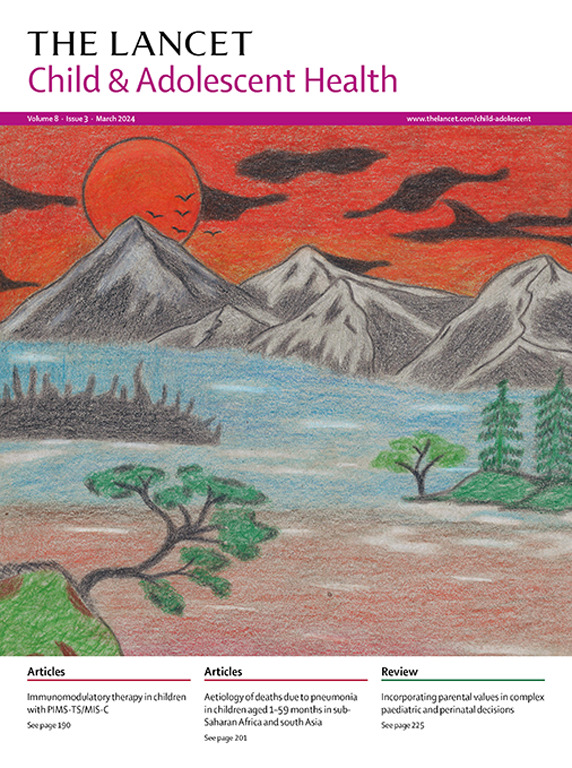Growth trajectories and risk of overweight and obesity in twins and singletons in the UK and USA: analysis of prospective national cohort data
IF 15.5
1区 医学
Q1 PEDIATRICS
引用次数: 0
Abstract
Background
Twin and singleton growth might be adaptively different to maximise survival in a shared intrauterine environment, translating to smaller average twin birthweight. We aimed to compare growth trajectories and risks of overweight and obesity between twins and singletons.
Methods
We leveraged height, weight, and BMI data from two large and ongoing nationally representative cohorts, the Millennium Cohort Study (MCS) and the National Longitudinal Survey of Youth—Child and Young Adult (NLSY-CYA), that have prospectively collected data from children born in the UK between Sept 1, 2000, and Jan 11, 2002, and participants born in the USA between December, 1970, and January, 2008, respectively, every 2–3 years from birth to adulthood. In each cohort and for a sample combined from both cohorts, we compared growth trajectories of twins and singletons from birth to age 18 years using adjusted predicted means for height, weight, and BMI each year of age derived from mixed models with a cubic function for child age (months), random intercept and slope for age, and a nested intercept for family identity to account for twin clustering. We stratified analyses by sex and by gestational age at delivery and evaluated overweight and obesity risk overall using Poisson regression models with robust error variance. Overweight and obesity were defined using age (months) and sex-specific BMI cut-points from the International Obesity Task Force.
Findings
MCS included 18 967 singletons and 502 twins with at least one height or weight measurement. NLSY-CYA included 11 133 singletons and 246 twins with at least one height or weight measurement. The full sample combined from the two cohorts included 748 twins and 30 106 singletons with measurements up to age 18 years. Twins were shorter than singletons by between 1·22 cm (95% CI 0·69–1·75) at age 3 years and 1·08 cm (0·10–2·05) at 18 years. Twins weighed less than singletons by between 0·82 kg (95% CI 0·49–1·16) at 3 years and 1·93 kg (0·46–3·40) at 18 years, with 0·44–0·76 kg/m2 lower BMI during this age range. Differences in growth remained when accounting for gestational age at delivery. Analysis of growth trajectories stratified by sex suggest that female twins are catching up with female singletons in late adolescence, with no height difference remaining between female twins and female singletons by age 18 years. At any time between ages 3 and 18 years, twins had lower risk of overweight (adjusted risk ratio 0·78 [95% CI 0·69–0·88]) and obesity (0·77; [0·61–0·96]) than singletons.
Interpretation
Twins from UK and USA cohorts do not catch up with singletons in height or weight but became more similar in BMI by age 18 years. Lower risk of overweight or obesity in twins should be investigated further in the context of cardiometabolic health.
Funding
None.
英国和美国双胞胎和单胎超重和肥胖的生长轨迹和风险:前瞻性国家队列数据分析
背景双胞胎和单胎的生长可能存在适应性差异,以便在共享的宫内环境中最大限度地提高存活率,从而导致双胞胎的平均出生体重较小。我们的目的是比较双胞胎和单胎的生长轨迹和超重和肥胖的风险。方法:我们利用了两个正在进行的具有全国代表性的大型队列——千禧年队列研究(MCS)和全国青少年和青年纵向调查(NLSY-CYA)的身高、体重和BMI数据,这两个队列分别前瞻性地收集了2000年9月1日至2002年1月11日在英国出生的儿童和1970年12月至2008年1月在美国出生的参与者的数据,每隔2-3年从出生到成年。在每个队列和两个队列合并的样本中,我们比较了双胞胎和单胎从出生到18岁的生长轨迹,使用调整后的身高、体重和每年年龄的BMI预测均值,这些预测均值来自混合模型,其中包含儿童年龄(月)的三次函数,年龄的随机截距和斜率,以及用于解释双胞胎聚类的家庭身份的嵌套截距。我们按性别和分娩时胎龄进行分层分析,并使用具有稳健误差方差的泊松回归模型评估超重和肥胖风险。超重和肥胖是根据国际肥胖工作组的年龄(月)和性别特异性BMI切点来定义的。smcs包括18967名单胎和502名双胞胎,至少有一项身高或体重测量。NLSY-CYA包括11133名单胎和246名双胞胎,至少有一项身高或体重测量。这两个队列的全部样本包括748名双胞胎和30106名单胎,年龄一直到18岁。双胞胎在3岁时比单胎矮1.22 cm (95% CI 0.69 - 1.75), 18岁时比单胎矮1.08 cm (95% CI 0.10 - 2.05)。双胞胎在3岁时体重比单胎轻0.82 kg (95% CI 0.49 - 1.16), 18岁时体重比单胎轻1.93 kg (95% CI 0.46 - 3.40),这一年龄段的体重指数比单胎低0.44 - 0.76 kg/m2。当考虑到分娩时的胎龄时,生长差异仍然存在。按性别分层的生长轨迹分析表明,女性双胞胎在青春期后期正在赶上女性独生子女,到18岁时,女性双胞胎和女性独生子女之间的身高差距已经消失。在3 ~ 18岁的任何时间,双胞胎的超重风险(校正风险比0.78 [95% CI 0.69 ~ 0.88])和肥胖风险(0.77;[0.61 ~ 0.96])均低于单胎。来自英国和美国的双胞胎在身高或体重上赶不上单胎,但在18岁之前,他们的身体质量指数变得更加相似。双胞胎超重或肥胖的风险较低应在心脏代谢健康的背景下进一步研究。
本文章由计算机程序翻译,如有差异,请以英文原文为准。
求助全文
约1分钟内获得全文
求助全文
来源期刊

Lancet Child & Adolescent Health
Psychology-Developmental and Educational Psychology
CiteScore
40.90
自引率
0.80%
发文量
381
期刊介绍:
The Lancet Child & Adolescent Health, an independent journal with a global perspective and strong clinical focus, presents influential original research, authoritative reviews, and insightful opinion pieces to promote the health of children from fetal development through young adulthood.
This journal invite submissions that will directly impact clinical practice or child health across the disciplines of general paediatrics, adolescent medicine, or child development, and across all paediatric subspecialties including (but not limited to) allergy and immunology, cardiology, critical care, endocrinology, fetal and neonatal medicine, gastroenterology, haematology, hepatology and nutrition, infectious diseases, neurology, oncology, psychiatry, respiratory medicine, and surgery.
Content includes articles, reviews, viewpoints, clinical pictures, comments, and correspondence, along with series and commissions aimed at driving positive change in clinical practice and health policy in child and adolescent health.
 求助内容:
求助内容: 应助结果提醒方式:
应助结果提醒方式:


